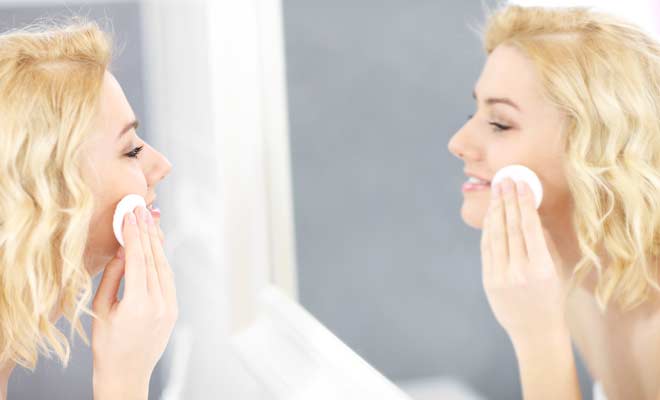Cleanse twice or thrice and you’re not exactly going to get twice or thrice as clean as if you only did it once.
And what of double cleansing?
Washing your face more than once in a single session does not necessarily leave your skin better cleansed but, it can just well leave it drier than if you just did a single wash.
So, then, how many times should you cleanse your face? The straight answer is, “It depends”.
Case by case
How many times you should wash your face remains to be a hot topic, largely yet to be resolved even among skincare experts.
Some say that washing should be done twice daily, once in the morning and another one at night, and say further that it goes for all skin types.
The rest have other opinions. Some of the advice you to listen to your skin.
If you have oily skin, do it twice daily at most and even a third wash in the middle of the day should be fine.
On the contrary, if you have dry skin, you should only wash it at night.
It doesn’t stop there.
Most at least seem to agree that a gentle cleanse is necessary after a sweaty workout to prevent sweat from attracting dirt and trapping in oil which eventually forms debris that ends up clogging your pores and infecting your skin.
The low-down in cleansing then is that there is no one rule that applies to everyone.
Why You Should Listen to What Your Skin tells You?

Know more about your skin – Image/Shutterstock
While it may seem absurd to be discussing in detail something as mundane as cleansing your face, just exactly how you do it can make or break your anti-aging skincare today and in the years to come.
Cleansing is important in ridding your face of dirt, dust, and sebum day after day.
The downside though is that you can overdo it, and when you do, you end up drying your skin.
Then, it becomes a vicious cycle that eventually suffers your skin — your skin dries up, your skin produces more sebum as a reaction to dryness, your pores get clogged — and the cycle goes on.
Over time, you get acne breakouts, perennial blackhead and whitehead problems, premature skin aging, and rough skin.
The Right Way To Cleanse
How you cleanse your skin is just as important as how many times you cleanse.
Do it once but do it roughly, you end up doing your skin the same amount of damage as when you cleanse several times daily.
Get your facial cleansing routine right by following these five simple tips below:
Tip No. 1: Choose the cleanser that will do beneficial things for your skin
Not all facial cleansers are the same.
Mind the labels and determine if your facial cleanser suits your skin type.
Thinner formulations like gels work better for oily skin, while creamier and moisturizer-infused facial cleansers best fit dry skin types.
Acne prone skin will benefit from facial cleansers that contain benzoyl peroxide, salicylic acid[1], glycolic acid[2] or lactic acid in them.
Mature skin will likewise benefit from cleansers that contain these Alpha and Beta Hydroxy Acids but it’s best to have moisturizers in the same formulation too.
In any case, it’s best to rid the labels always and stay away from harmful ingredients — parabens, sulfates, phthalates, phenoxyethanol, aluminum, fragrances, and colorants which are irritating to your skin and harmful to your overall health.
Tip No. 2: Wipe off your makeup before cleansing
You don’t wash your face without wiping off your face with soft cotton and a good, oil-based makeup remover first.
Get those layers of colors and creams out first so that your cleanser can penetrate and cleanse your face more deeply.
You don’t do it the other way around either or you’ll be leaving on too much excess oil from your makeup remover.
Tip No. 3: Rub in only with clean hands.
Don’t pick up your cleanser just yet!
Get your hands squeaky clean first before putting them anywhere near your face.
Tip No. 4: Keep your tools clean
Whether you are using a facial brush or a washcloth or something else, make sure these are not overly abrasive for your skin type, and that cleanliness is maintained all the time.
Replace your tools regularly to keep bacteria off of your skin. And, remember to cleanse with just gentle pressure on, nothing more.

Use clean and proper tools – Image/Shutterstock
Tip No. 5: Use lukewarm water with your cleanser
Don’t use water that’s too hot or too cold for your skin.
Either way and it can cause your skin to be stripped of natural oils.
Make it lukewarm and leave it almost untouched, except it’s cleaner.
FAQ’s:
Que: How often should you use a face cleanser?
Ans: You should always wash your face at least once a day.
Que: How many times to wash face for oily skin?
Ans: People with oily or combination skin may benefit from twice-daily washes.
Que: How many times should I wash my face if I have acne?
Ans: Whether or not you have acne, it’s important to wash your face twice daily to remove impurities, dead skin cells, and extra oil from your skin’s surface.
Conclusion
Stick to facial cleansers that are mild and non-irritating, and put on only pressure that’s gentle enough so as not to strip your skin bare of natural oils and leave it dry and damaged.
When it comes to facial cleansing, you should keep in mind that too much good ole’ cleansing is also bad and damaging to your skin.

 By Wendy Gould
By Wendy Gould






